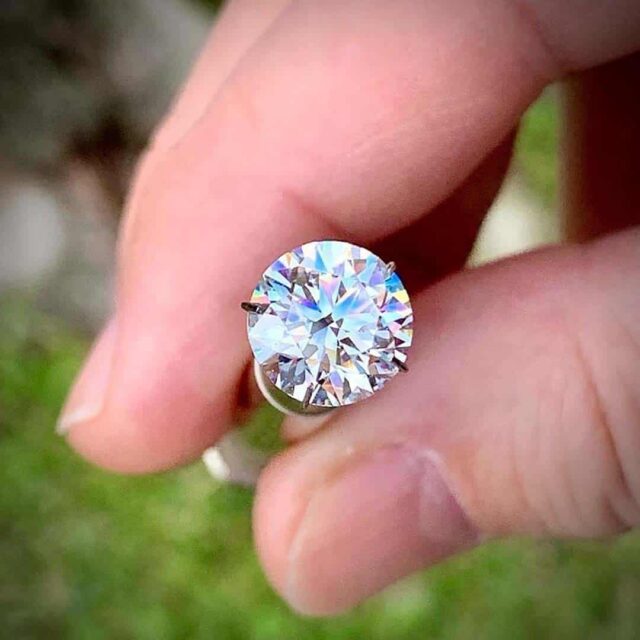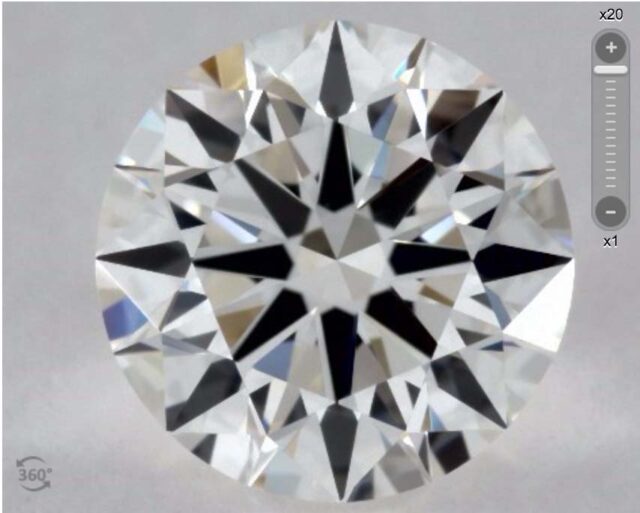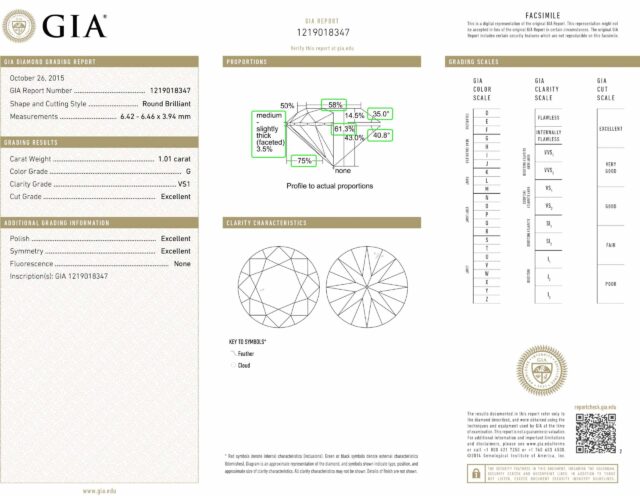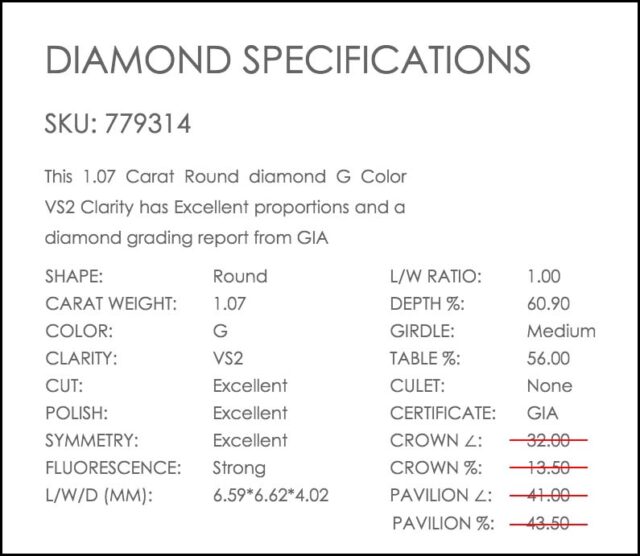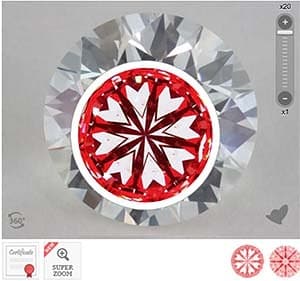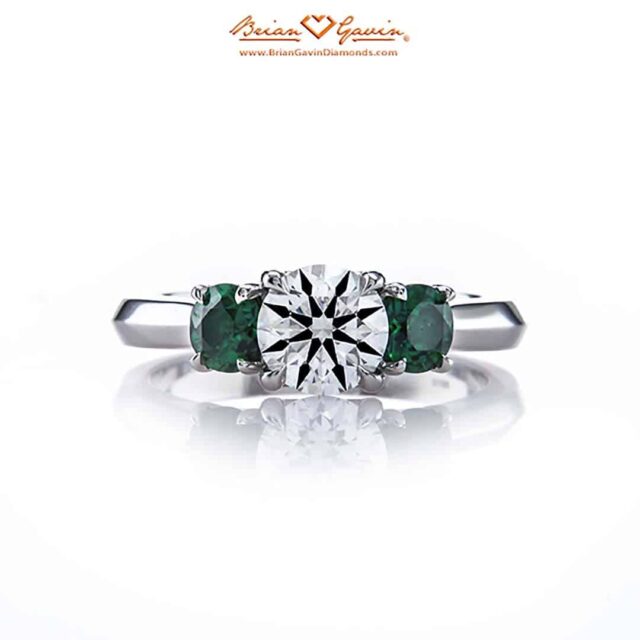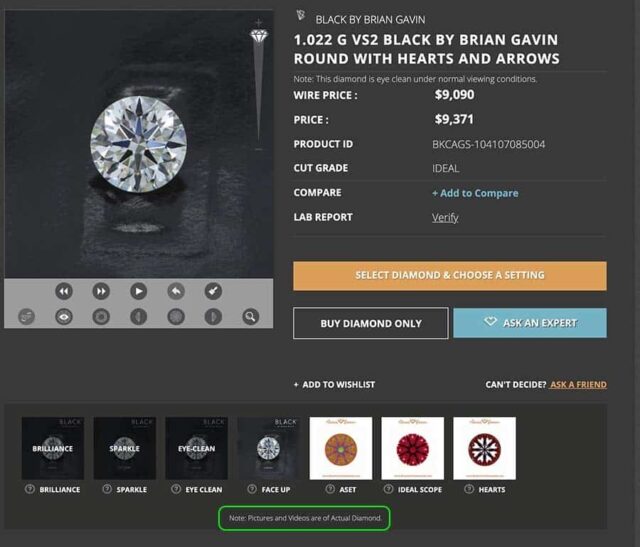An Ideal Cut Diamond has specific proportions that produce higher degrees of light return and performance, including a sparkle factor that is vivid and intense. Industry sources estimate that fewer than 1% of round brilliant cut diamonds qualify for the ideal designation.
Even less meet our selection criteria because the proportions range is too broad. Most of the ideal cut diamonds below will not be available when you read this.
At the same time, it doesn't really matter if they are available or not. After all, I'm going to teach you how to evaluate ideal cut diamonds like a pro. In that case, just follow along and note the reasons why we recommend one ideal cut diamond over another.
Consequently, this evaluation began with somebody submitting a request for help via our Diamond Concierge Service. There were 78 ideal cut diamonds available from James Allen within his price range.
Diamond and Jewelry Coupons & Sales:
* See individual sites for terms and conditions.
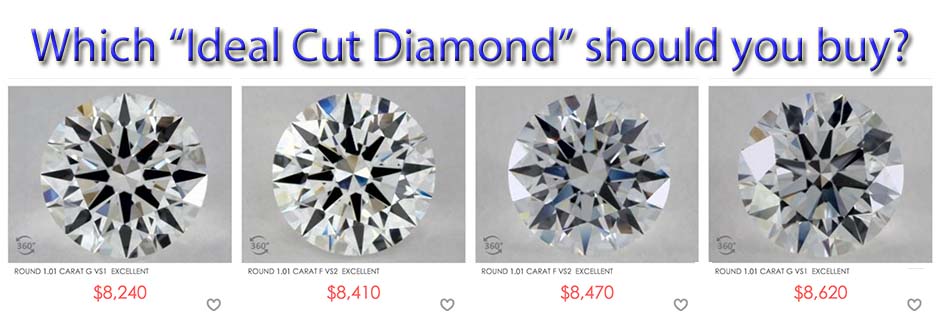
Which Ideal Cut Diamond Should You Buy?
Which GIA Excellent Ideal Cut Diamond Should You Buy?
Needless to say, the prospect of trying to choose between all those options can be overwhelming. This particular client sent me a link and simply asked "Which ideal cut diamond should I buy?"
It might seem like a daunting task, seeing that there were 78 diamonds in the search results. However, it only took me a few minutes to select the best options from the group.
For the purpose of illustration, let's begin by looking at the diamonds in the face-up position. There are dramatic differences in the pattern of light return, as can be seen in the screenshot above.
If a diamond doesn't look good in the face-up position, then there's no point in going further. At the same time, I like to compare the proportions with what I see in the clarity photographs.
With that in mind, let's right-click on each image and open up the diamond details pages in a new tab. Then click on the diamond grading report straightaway to determine whether the proportions meet my selection criteria.
How To Pick the Best Looking Ideal Cut Diamond:
As a matter of curiosity, which of the four diamonds in the picture above look best to you?
Most people will choose the first diamond, of course, because it's reflecting light more evenly than the rest. That is to say that you're likely to choose the diamond we're about to evaluate.
After all, this 1.01 carat, G-color, VS-1 clarity, GIA Excellent round cut diamond from James Allen looks the best. In the first place, the pavilion angle of 40.8 degrees should produce a high volume of light return.
At the same time, the 35.0 degree crown angle should produces a virtual balance of brilliance and dispersion. In addition, the 75% lower girdle facet length should produce broad-spectrum sparkle.
Consequently, this GIA Excellent cut diamond has a total depth of 61.3% and a 58% table diameter. Given these points, this diamond is within the Top 1% of the annual production for rounds.
Why Look Beyond the Proportions:
As a matter of fact, this diamond has proportions within the range I recommend. In addition, the diamond exhibits strong contrast brilliance as can be seen in the photograph above.
Unfortunately, we can't judge the light performance because James Allen doesn't provide ASET or Ideal Scope images. On that note, James Allen generally only provides Ideal Scope images for their True Hearts diamonds.
Consequently, the other diamonds at the top of the page do not meet my selection criteria. Under those circumstances, there really isn't any point in discussing them further.
Obviously, it makes more sense to teach you how to select the best ideal cut diamond available. With that in mind, we’re going to open up the diamond details pages in separate tabs. And then, we'll figure out which of these ideal cut diamonds from James Allen really is the best.
Best Proportions for Ideal Cut Diamonds:
This seems like a good time to talk about diamond proportions. Since I’m waiting for 78 diamond details pages to open in separate tabs within my internet browser. With this in mind, here’s what I recommend you look for:
We'll eliminate everything with proportions beyond this range as soon as the diamond details pages are open. In other words, you shouldn't deviate from the range of proportions above. After all, any deviation from this formula is likely to result in a loss of light performance.
Why GIA Excellent Might Not Be Good Enough:
As an illustration, we'll use this 1.07 carat, G-color, VS-2 clarity, GIA Excellent cut round diamond from James Allen. In the first place, the crown angle is too shallow while the pavilion angle is too steep.
It's important to realize that a 41 degree pavilion angle is not likely to produce higher degrees of light return. Furthermore, the 43.5% pavilion depth is essentially the kiss of death.
In fact, the 43.5% pavilion depth is the critical tipping point where most light leakage occurs. At the same time, the 32 degree crown angle significantly reduces the volume of dispersion/fire.
Obviously, this GIA Excellent cut diamond does not meet my selection criteria. As a matter of fact, the only ones that have potential are the seven GIA Excellent cut diamonds below.
Ideal Cut Diamonds With Potential:
Using H&A and Ideal Scope Images:
This 1.06 carat, F-color, VS-2 clarity, James Allen True Hearts diamond also looks promising. In addition to having the right proportions, we're able to verify the light return using reflector scope images. At the same time, this diamond has an overall grade of AGS Ideal-0 for Light Performance.
However, the diamond grading report does not feature the Angular Spectrum Evaluation Tool (ASET) map which gives me pause. ASET images come standard on the more advanced AGS Light Performance DQD and provide additional insight which is invaluable. As can be seen, there are only minor variances in the size and shape of the hearts.
You’ll be able to see a little extra space around the tip of the hearts in the 5-7-8-10 o’clock positions if you look closely. At the same time, the heart in the ten o’clock region is a little smaller than the others.
Conversely, this diamond does not meet my selection criteria for Hearts & Arrows. However, the degree of optical precision does appear to be better than average ideal cut diamond. In addition, this diamond looks pretty good in the Ideal Scope image.
The Super Ideal Cut Diamond Classification:
As a matter of fact, I usually don't waste my time looking at standard ideal cut diamonds. On the condition that they're likely to still leak a lot of light despite having the right proportions. Given that fewer than 0.001% of round diamonds exhibit the optical precision necessary to improve light performance.
With this in mind, I prefer to set my sights on Hearts & Arrows super ideal cut diamonds. In the first place, these diamonds have proportions within "the sweet spot" of my selection criteria.
Together with the higher degree of optical precision these diamonds exhibit, you'll see a higher degree of light return. At the same time, this combination produces more virtual facets within the diamond. That means that there will be more sparkle and it's also going to be more vivid and intense.
It's no secret that Brian Gavin is one of my favorite suppliers for super ideal cut diamonds. As a matter of fact, my son's engagement ring on the left features a Black by Brian Gavin Diamond.
By the way, this is the Diana setting by Brian Gavin with 4 mm green Tsavorite accents in platinum.
A Picture Is Worth A Thousand Words:
Consequently, Brian Gavin's production quality is extremely consistent in my experience. Which makes it easier to buy a spectacular looking super ideal cut diamond with confidence. In addition, their diamond details pages provide all the details necessary to verify the sparkle factor:
As shown above, Brian Gavin provides you with high-resolution video and photographs of the actual diamond. In addition, they also give you the following reflector scope images:
Furthermore, every Brian Gavin Signature diamond has an overall cut grade of AGS Ideal-0. By the same token, the diamonds are graded on the AGS Light Performance grading platform. The reflector scope images shown above and the ASET on the lab report enable you to verify the light performance.
At the same time, I want you to see how evenly light is reflecting throughout the diamond above. Notice the even distribution of hue and saturation throughout the images. In view of these facts, it's clear that Brian Gavin Diamonds are a cut above the rest.
Black by Brian Gavin & Signature Collections:
As stated previously, I'm partial to the sparkle factor that Brian Gavin's super ideal cut diamonds deliver. This should come as no surprise since Brian cut most of the diamonds in our private label collection.
As a matter of fact, I’ve personally evaluated thousands upon thousands of diamonds produced by Brian Gavin. With this in mind, it's fair to say that I know exactly what to expect from the brand:
Brian Gavin Diamonds Are About Consistency.
100% Consistency. No Guesswork or Finger-crossing Required.
Consequently, Brian Gavin Signature Hearts & Arrows diamonds cost more than than standard ideal cut diamonds. Of course, it also takes about four times longer to achieve the higher degree of optical precision. Time is money, as the saying goes, and it takes more time to produce these diamonds. However, they're also going to sparkle more and that sparkle factor will be more vivid and intense!
In similar fashion, a Porsche GT3 RS is more expensive than a 911 Turbo which also costs more than a non-turbo. While these automobiles might look similar to the casual observer, there are clear differences in performance.
With that in mind, you should buy from Brian Gavin if you want to Win the Light Performance Gran Prix. At the same time, there's no need for me to provide you with a list of diamonds to choose from. After all, I’ve yet to reject a single Brian Gavin Signature Diamond for cut quality.
Of course, there is always the chance that I might not like some of the clarity characteristics. However, I generally find that Brian Gavin and I use similar evaluation strategies. As a matter of fact, I've sat in and observed Brian's evaluation process on several occasions. We're like two peas in a pod when it comes to how we see diamonds!
Where to Buy Ideal Cut Diamonds Online:
Whenever I look for ideal cut diamonds, I tend to search in this order:
Why I Search In This Particular Order:
As a matter of fact, the list above reflects the likely order of diamond cut quality and performance. After all, it's clearly evident that Brian Gavin is in a class of their own.
Generally speaking, it seems like Whiteflash ACA, Victor Canera and James Allen True Hearts diamonds are comparable. The production standards of Brian Gavin are the most consistent. Some of the Whiteflash diamonds are definitely better than others and the same can be said for Victor Canera and James Allen.
You should also check out Blue Nile and Ritani because you never know what you'll find. However, they rarely provide clarity photographs or reflector scope images on their diamond details pages. Consequently, I've never found an H&A quality diamond in their inventory.
In other words, they don't sell H&A diamonds and you'll be making a decision with little more than the information from the lab report. Be that as it may, I'm sometimes able to find additional images via the multiple listing services.
Consequently, be sure to ask me whether additional images are available for any virtual diamonds you may be considering. After all, it only takes me a minute to look up a diamond by lab report number.
Of course, I’m going to replace whatever link you send me with one of my own affiliate links. In either case, clicking on those affiliate links creates a Win/Win Scenario and does not affect your purchase price.
In light of what you've learned here today, I hope you see the benefit of supporting our efforts.

